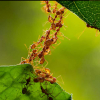tip/care sheet from Noebl1
Prenolepis Imparis
1. Year one treat them as normal ants (like Lasius)
2. Put them into diapause later then most, usually Nov is fine, keep them in the 40-50Fs during ( didn't even put them into a wine cooler but basement temps in that range)
3. Pull them out Jan-March
4. Offer loads of protein and sugar, even if they don't have any brood
5. They should fatten up and have plenty of fat workers in Spring
6. In May/June make sure you keep up sugar and proteins even without brood, they should gorge themselves for summer estivation. Also make sure they have plenty of water (how I almost lost one colony this SPring)
7. During diapause, keep them warm... 70 - 80F is fine, treat them like Lasius, except they won't do anything
8. If all goes well, sometime in June/July they will relay and feed brood entirely off repletes
9. As workers eclose, they will start to forage again end of August
10. repeat step 2
Edit:
P.s. they'll get boring at some point, so be ready for that
P.p.s it is more interesting/fun when you have several queens in the colony
Edited by AleeGuy, December 28 2020 - 4:46 PM.
















